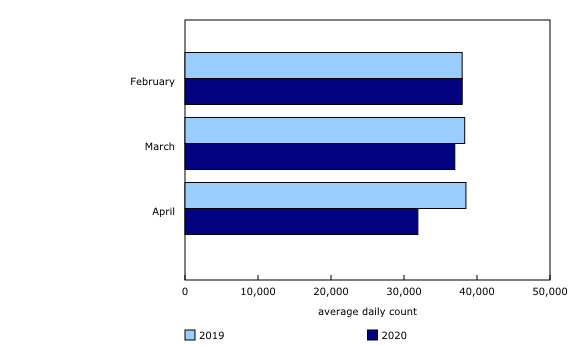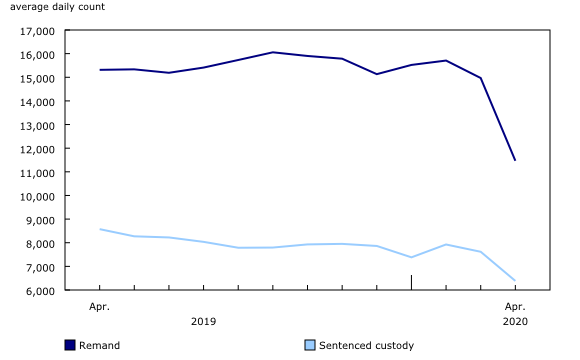Changes in federal, provincial and territorial custodial populations during the COVID-19 pandemic, April 2019 to April 2020
Archived Content
Information identified as archived is provided for reference, research or recordkeeping purposes. It is not subject to the Government of Canada Web Standards and has not been altered or updated since it was archived. Please "contact us" to request a format other than those available.
Released: 2020-08-12
There were about 6,000 fewer people in a correctional institution in April 2020 compared with two months earlier, a drop of 16% in the custodial population, as governments across Canada took steps to contain the COVID-19 pandemic.
The COVID-19 pandemic has led to many health and safety challenges for Canadians, particularly for populations in correctional institutions. Correctional institutions face unique challenges when it comes to preventing COVID-19 infection and transmission among custodial populations, given the close-proximity living conditions and the lack of physical distancing options.
The Correctional Service of Canada (CSC) has made its COVID-19 testing information publicly available, and this indicates the risk that COVID-19 can pose to federal correctional programs. As of August 6, 2020, 1,496 COVID-19 tests had been conducted on the federal custodial population, and about one-quarter (24%) of these were positive. All individuals have recovered with the exception of one ongoing case and two confirmed deaths (see CSC's page about COVID-19).
Federal, provincial and territorial correctional programs have been working closely with the Public Health Agency of Canada, as well as provincial and territorial health authorities, to implement measures to ensure the continued health, safety and well-being of employees and people in custody and to maintain safe and secure environments (see note to readers).
Reducing the number of people held in correctional institutions is also seen as a preventive measure to reduce the public health risk. Some of the steps taken by the Canadian justice and correctional systems to reduce the size of the population living in correctional institutions since the onset of the COVID-19 pandemic include temporary or early release of people in custody who are considered at low risk to reoffend; extended periods for parole appeals and access to medical leave privileges; and alternatives to custody while awaiting trials, sentencing and bail hearings.
Adult custodial population in Canada declines by one-sixth from February to April
In February 2020, just before COVID-19 began spreading in Canada, there was an average of 37,976 adults in federal, provincial and territorial custody on any given day. There were 3% fewer people in custody in March, the month in the middle of which the pandemic was declared in Canada. By April, the average daily count of adults in custody was down 16% from February to 31,901 and stood 17% below the custodial population in April 2019.
These month-to-month changes are unprecedented. Typically, correctional population average daily counts tend to be stable over time, with slight variations occurring over longer periods. For example, from 2014/2015 to 2018/2019, the average change in monthly average daily counts of adults in custody was under 1% at the federal level and just over 1% at the provincial and territorial level. While the current high-level data provide evidence of the magnitude of the change during COVID-19, they cannot indicate the extent to which temporary and early release or alternatives to custody contributed to these unprecedented custody counts. More detailed data are being collected from correctional service programs, and these will provide a more comprehensive picture of the impacts of COVID-19 on the reduction of custodial populations in Canada.
Federal custodial population declines during early stages of the pandemic
In Canada, the administration of correctional services is a shared responsibility between the federal, provincial and territorial governments. CSC is responsible for the federal system and has jurisdiction over adults (aged 18 and older) serving custodial sentences of two years or more, including all those serving indeterminate prison sentences and those designated as dangerous offenders.
The average count of adults in federal custody fell from 13,957 in March to 13,720 in April, a decline of 2%. Monthly counts, taken at the mid-point of each month, were relatively unchanged from February to March and were otherwise very stable in 2019/2020, with an average change of less than 0.5% per month. Given that the March counts were taken at mid-month, they do not reflect the full impact of COVID-19, as measures to address the pandemic began to be implemented in the second half of the month (see note to readers about differences in counting between the federal and provincial or territorial correctional systems).
Custodial populations down in every provincial or territorial correctional program
Provincial and territorial correctional service programs are responsible for adults serving custodial sentences of two years or less (including those on intermittent sentences, to be served typically on weekends with intermittent releases to the community on weekdays), as well as those who have been remanded in custody (individuals awaiting trial or sentencing).
Provincial and territorial custodial populations declined 4% from February to March. By April, the average count of adults in provincial or territorial custody was 18,181 people, down by one-quarter (25%) from February (24,085 people).
All 13 provincial and territorial correctional service programs in Canada reported a decrease in the number of adults in custody from February to April. During this time, seven jurisdictions (Newfoundland and Labrador, Prince Edward Island, Nova Scotia, Ontario, Alberta, British Columbia, and Yukon) reported declines above the national average of 25%. Nova Scotia (-41%) reported the largest decline, while Nunavut (-14%) and Quebec (-15%) reported the smallest.
Remand population down sharply compared with the sentenced population in provincial and territorial correctional institutions
Since 2004/2005, the provincial and territorial adult remand population (those awaiting trial or sentencing) has been larger than the adult sentenced custody population and has been gradually increasing as a proportion of the overall custodial population. The remand population accounted for about two-thirds (65%) of adults in custody in 2019/2020.
After remaining fairly stable for most of 2019/2020, both the remand (-27%) and the sentenced custody (-19%) populations in adult provincial and territorial correctional programs fell sharply from February to April.
From February to April, the decrease in the remand population outpaced the drop in the sentenced custody population in Newfoundland and Labrador, Ontario, Manitoba, Alberta, British Columbia, Yukon, and Nunavut. Conversely, in Prince Edward Island, Nova Scotia, New Brunswick, Quebec and the Northwest Territories, the sentenced custody population fell at a faster pace than the remand population. In Saskatchewan, the two populations decreased at about the same pace.
The female custodial population declines at a faster pace than the male population in provincial and territorial institutions
The custodial population of females in provincial or territorial institutions declined 40%, from 2,147 in February to 1,298 in April. This was almost double the rate for the male custodial population, which declined 23% from 21,938 to 16,883.
The female custodial population decreased at a faster pace than the male custodial population in every jurisdiction except Prince Edward Island and Yukon, which have very few females in custody and are therefore more subject to statistical variability.
Note to readers
Some protective measures implemented by correctional institutions to reduce COVID-19 transmission include providing personal protective equipment to staff; increasing access to hygiene and cleaning supplies for people in custody and correctional staff; increasing physical health screening at intake; suspending inter-regional and international transfers of people in custody; suspending in-person visits to correctional facilities; and increasing the use of technology to support video visitation with family and, in some cases, court appearances. Furthermore, protocols have been implemented for assessing, testing and isolating people in custody suspected or confirmed to have a communicable disease.
Statistics Canada's Adult Corrections Key Indicator Report (KIR) collects data from all adult correctional service programs in Canada that provide an average daily count of people in federal, provincial and territorial custody, for each month of the year. To do this, correctional services generally take a count of people in custody each day of the month, and it is averaged over the number of days in that month. At the federal level, the monthly numbers represent the counts at the mid-point of each month as reported by the Correctional Service of Canada (CSC) and include people in custody on temporary absence.
Data on the sex of the federal custodial population are not collected as part of the KIR administered to CSC and are therefore not included.
As correctional service programs continue to manage custodial institutions during the COVID-19 pandemic, Statistics Canada will continue to provide KIR data on custodial populations on a more frequent basis. An upcoming report in fall 2020 will provide an update on changes to custodial population counts during the months of May and June 2020.
There may be differences in jurisdictional operations, custodial populations and implementation of measures to address COVID-19 among correctional service programs, resulting in differences in the relative decreases in custodial populations. Caution should be used in making any jurisdictional comparisons.
Contact information
For more information, or to enquire about the concepts, methods or data quality of this release, contact us (toll-free 1-800-263-1136; 514-283-8300; STATCAN.infostats-infostats.STATCAN@canada.ca) or Media Relations (613-951-4636; STATCAN.mediahotline-ligneinfomedias.STATCAN@canada.ca).
- Date modified:



